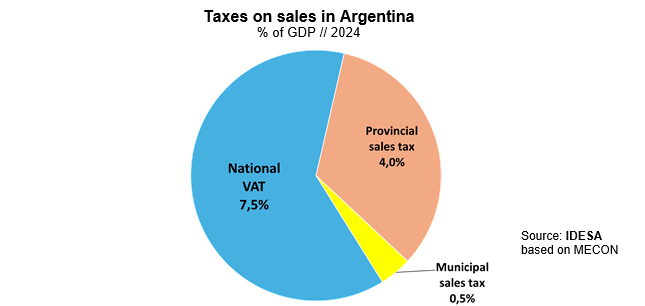Report Nº: 112111/05/2025
The exchange rate appreciation set the urgency to address the severe competitiveness problems suffered by domestic production. An essential step is to go forward with a tax reform eliminating the provincial and municipal sales tax. The best way to do it is to absorb both taxes with a “super-VAT”.

Argentina has several overlapping taxes charged on sales. On the one hand, the federal state levies the Value Added Tax (VAT) with a general rate of 21%, although there are goods and services exempted or with differential rates. The provinces apply a sales tax with hundreds of different rates and several dozen payment-in-advance regimes (the SIRCREB and SIRTAC are the best known). Municipalities apply another sales tax in a format similar in terms of diversity and complexity to the provincial sales tax.
The accumulation of taxes charged on the same base (sales) impacts prices not only because of the amounts they add to net prices but also because of the costly bureaucracy needed to pay them. In this sense, VAT is a much more modern tax, which is easier to administer and control. It distorts the production process less because each link in the production chain pays the tax only for the value it adds. On the other hand, provincial and municipal sales taxes multiply their incidence as they pass through the links of the value chain, raising internal production costs and making those who want to export and those who have to compete with imported goods less competitive.
In order to measure the challenge of eliminating provincial and municipal sales taxes, it is useful to see how much they collect. According to the Ministry of Economy for the year 2024, it is observed that:
These data show that tax on sales collects approximately 12% of GDP. This implies slightly less than half of consolidated public sector tax revenues. Sales taxes, by far, are the main source of resources for the three levels of government. Compared to developed countries, this is a distortion that should be corrected by lowering public spending and strengthening the income tax rather than the sales tax. As this change will take time, in the meantime, it is urgent and essential to eliminate provincial and municipal sales taxes.
The most practical and quickest way to eliminate provincial and municipal sales taxes is to absorb them with a “super-VAT”. A first advantage would be the transparency that will make explicit the exaggeratedly high tax burden on sales currently hidden in the overlapping of the three taxes. The second is that the administrative costs for taxpayers and the State will be lowered, increasing the possibility of reducing evasion, an essential step to reduce tax pressure. The third is that it increases the competitiveness of domestic production. VAT is a transparent tax that can be refunded to exporters and equalizes domestic product prices with imported product prices. In other words, it stops exporting taxes and makes domestic production compete without disadvantage with imported products.
In this sense, the announcement of the national government to rethink the VAT and the relationship with the provinces is a very auspicious approach. For this, it is essential to address the entire sales taxes problem. That is to say, to reform the taxes applied by the three levels of government in an overlapping manner (the national, provincial and municipal). Unification in the “super VAT” is the most direct and quickest way to address this challenge.
It is also the way to move towards the competition of tax rates among provinces proposed by the President. For three-quarters of the country in terms of population and GDP, it is feasible to establish a fiscal matching scheme. That is, each province would be financed by the taxes it collects from its citizens. For the rest of the country, made up of the smaller provinces whose low level of development makes it difficult for their public sector to be financed with their own taxes, an Equalization Fund must be established to maintain their current revenues. The small ones are many provinces, but because they are small, a fund of limited size would be sufficient.